Lecture Two Prototypes(1)
Prototype Theory
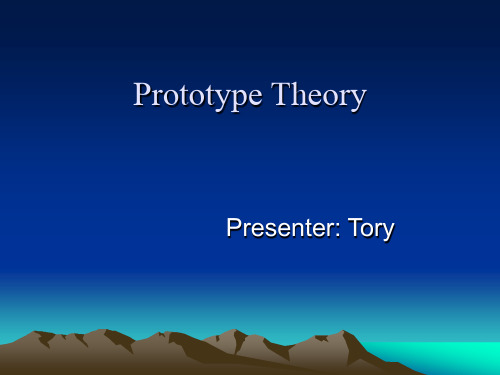
Rosch------Prototype Category Theory
• 语言学家Labov 和Rosch 先后发表了他们 对于自然范畴的试验研究结果,以此证明 维氏的“家族相似性”原理适用于描述自 然界中的许多范畴,即许多自然范畴都具 有维氏所说的“家族相似性”。Labov 和 Rosch 把具有“家族相似性”的这些自然 范畴称为“原型范畴”(prototype category),即具有原型(prototype, 即范 畴的典型成员)的范畴。从而建立了现代 范畴理论,原型范畴理论。
Definitions of Categorization
F.Ungerer & H.J.Schmid: The mental process of classification. And its products are the cognitive categories. Categorization is
E.g.
• furniture / chair/ table/ lamp/ kitchen chair/living-room chair /kitchen table/dining room table/floor lamp/desk lamp
Category
Definitions
赵艳芳:严格来讲,范畴是事物在认知中的归类。 F.Ungerer&H.J.Schmid: The product of the mental process of classification. They can be understood as mental concepts
• Definitions of Prototype • Basic contents of Prototype Theory • Factors that influence the Prototype
Lecture2_1SymbolicTech
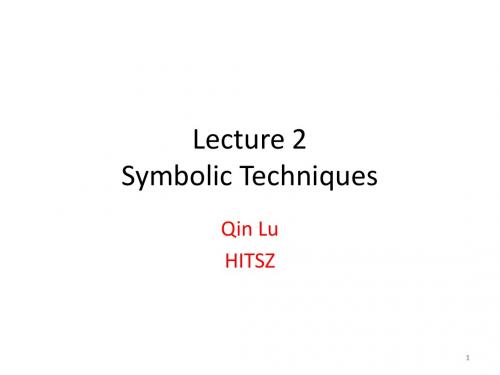
5
Lexical features
• Tokenization = converting input stream of characters into a stream of words or tokens – space-delimited languages (most European languages): • word = string of characters separated by white space – unsegmented languages (e.g., Chinese, Thai, Japanese): • e.g., use of a word list (MRD = machine-readable dictionary) • Tool: – Word Splitter /~cogcomp/atool.php?tkey=WS ( /page/tools_view/8) – Stop word list: /manuals/onix/stopwords1.html
• Porter Stemmer Tool: /~martin/PorterStemmer/
9
POS tagging and sentence parsing
• Part-of-speech (POS) or syntactical word class: – contributes to the meaning of the word in a phrase – distinct component in syntactic structure – content words: nouns, adjectives, verbs, adverbs – function words: have functional properties in syntactic structure: act as determiners, quantifiers, prepositions and connectives (e.g., articles, pronouns, particles, …)
ATRECSS — ATR ENGLISH SPEECH CORPUS FOR SPEECH SYNTHESIS
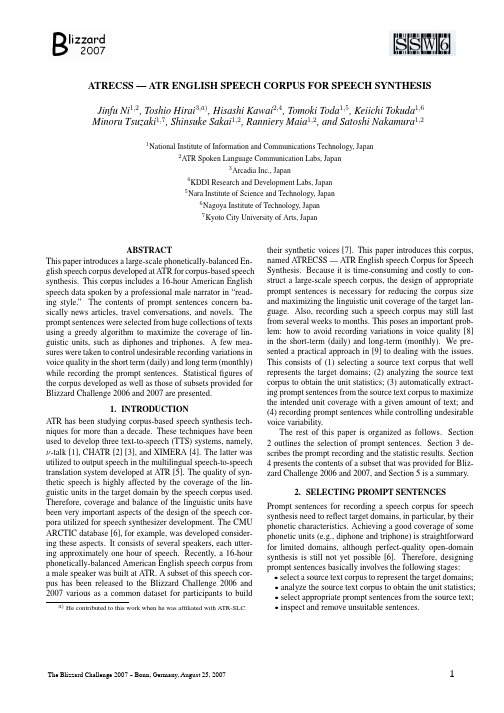
ATRECSS —ATR ENGLISH SPEECH CORPUS FOR SPEECH SYNTHESIS Jinfu Ni 1,2,Toshio Hirai 3,a ),Hisashi Kawai 2,4,Tomoki Toda 1,5,Keiichi Tokuda 1,6Minoru Tsuzaki 1,7,Shinsuke Sakai 1,2,Ranniery Maia 1,2,and Satoshi Nakamura 1,21National Institute of Information and Communications Technology,Japan2ATR Spoken Language Communication Labs,Japan3Arcadia Inc.,Japan4KDDI Research and Development Labs,Japan5Nara Institute of Science and Technology,Japan6Nagoya Institute of Technology,Japan 7Kyoto City University of Arts,JapanABSTRACTThis paper introduces a large-scale phonetically-balanced En-glish speech corpus developed at ATR for corpus-based speech synthesis.This corpus includes a 16-hour American English speech data spoken by a professional male narrator in “read-ing style.”The contents of prompt sentences concern ba-sically news articles,travel conversations,and novels.The prompt sentences were selected from huge collections of texts using a greedy algorithm to maximize the coverage of lin-guistic units,such as diphones and triphones.A few mea-sures were taken to control undesirable recording variations in voice quality in the short term (daily)and long term (monthly)while recording the prompt sentences.Statistical figures of the corpus developed as well as those of subsets provided for Blizzard Challenge 2006and 2007are presented.1.INTRODUCTIONATR has been studying corpus-based speech synthesis tech-niques for more than a decade.These techniques have been used to develop three text-to-speech (TTS)systems,namely,ν-talk [1],CHATR [2][3],and XIMERA [4].The latter was utilized to output speech in the multilingual speech-to-speech translation system developed at ATR [5].The quality of syn-thetic speech is highly affected by the coverage of the lin-guistic units in the target domain by the speech corpus used.Therefore,coverage and balance of the linguistic units have been very important aspects of the design of the speech cor-pora utilized for speech synthesizer development.The CMU ARCTIC database [6],for example,was developed consider-ing these aspects.It consists of several speakers,each utter-ing approximately one hour of speech.Recently,a 16-hour phonetically-balanced American English speech corpus from a male speaker was built at ATR.A subset of this speech cor-pus has been released to the Blizzard Challenge 2006and 2007various as a common dataset for participants to builda )He contributed to this work when he was affiliated with ATR-SLC.their synthetic voices [7].This paper introduces this corpus,named ATRECSS —ATR English speech Corpus for Speech Synthesis.Because it is time-consuming and costly to con-struct a large-scale speech corpus,the design of appropriate prompt sentences is necessary for reducing the corpus size and maximizing the linguistic unit coverage of the target lan-guage.Also,recording such a speech corpus may still last from several weeks to months.This poses an important prob-lem:how to avoid recording variations in voice quality [8]in the short-term (daily)and long-term (monthly).We pre-sented a practical approach in [9]to dealing with the issues.This consists of (1)selecting a source text corpus that well represents the target domains;(2)analyzing the source text corpus to obtain the unit statistics;(3)automatically extract-ing prompt sentences from the source text corpus to maximize the intended unit coverage with a given amount of text;and (4)recording prompt sentences while controlling undesirable voice variability.The rest of this paper is organized as follows.Section 2outlines the selection of prompt sentences.Section 3de-scribes the prompt recording and the statistic results.Section 4presents the contents of a subset that was provided for Bliz-zard Challenge 2006and 2007,and Section 5is a summary.2.SELECTING PROMPT SENTENCESPrompt sentences for recording a speech corpus for speech synthesis need to reflect target domains,in particular,by their phonetic characteristics.Achieving a good coverage of some phonetic units (e.g.,diphone and triphone)is straightforward for limited domains,although perfect-quality open-domain synthesis is still not yet possible [6].Therefore,designing prompt sentences basically involves the following stages:•select a source text corpus to represent the target domains;•analyze the source text corpus to obtain the unit statistics;•select appropriate prompt sentences from the source text;•inspect and remove unsuitable sentences.2.1.Source text corpusTwo domains were taken into account to construct our En-glish speech corpus for speech synthesis:(1)conversational communication,and(2)news-reading.Consequently,we ex-tracted prompt sentences from huge collections of texts(here-after referred to as source text corpora)described below.1.An English Basic Travel Expression Corpus(BTEC),2.a large-scale English newspaper corpus(NEWS).The two text corpora werefirst pre-processed bying a Festival[10]tool to decompose every para-graph in the text corpora into utterances(a predictedunit in[10]whose size extends from a phrase to a clause).2.Grouping utterances into sentences determined simplyby specific punctuation marks,such as“.!?”;thus asentence may comprise one or more utterances.3.Filtering out long sentences in order to enable naturaluttering.More specifically,all the sentences that havemore than25words werefiltered out.Also,wefilteredout short sentences in NEWS corpus so as to keep theaverage sentence length relatively long.A Festival[10]tool was then used to analyze the source text corpora for obtaining the statistics of basic units(mono-phones,diphones,triphones),POS(part of speech),andfind-ing out potential distinct diphones and triphones(hereafter re-ferred to as diphone/triphone types)existing in the source text corpora.There were34POS tags and40phonemes(mono-phones)plus an extra/pau/(pause/silence).A/pau/is always assumed at the beginning and ending of a sentence,and it is also used to separate any two adjacent utterances.Figure1shows the monophone distributions for the two source text corpora.The monophone with lowest occurrence is/zh/with0.034%in BTEC and0.069%in NEWS.Table1 shows counts of the units existing in the text corpora.While there are,for example,1,680distinct diphones in theory[1,680 =41×41–1(i.e.,/pau/–/pau/)],there actually exist only 1,472diphone types in BTEC and1,597in NEWS.Table 2shows Kullback-Leibler divergences between BTEC and NEWS for POS,monophones,diphones,and triphones.These results indicate that the distributions of units such as POS, diphone and triphone are different to some extent between news-writing and conversational texts.For this reason,we extracted two sentence sets,each from BTEC and NEWS sep-arately,using a greedy algorithm that is roughly described in the next section.Table1.Count of basic units in the source text corpora. Corpus#Words#Sentences#Diphone#Triphone(million)types typesBTEC 3.77749.5k1,47226,657 NEWS22.024,985.2k1,59740,499ou a o a e a e a u a e a i i a t n s r l k d z d p y h f v b n g s j t c zPhonemePercentage(%)Fig.1.Distribution of the40monophones existing in BTEC and NEWS text corpora.Table2.Divergence between BTEC and NEWS text corpora.Divergence POS Monophone Diphone Triphone KL(BTEC,NEWS)0.2290.0300.1530.4892.2.Prompt sentence extractionA greedy algorithm in[9]was used to extract a sentence set from a text corpus while maximizing the unit coverage.A unit type may be diphone,triphone,or POS in this paper,and the unit coverage is calculated in the following way.Let U i be a predefined set of linguistic units like POS,monophone,etc.,where U i={u i1,...,u in i}with size n i.Let S be a sentence set extracted from a text corpus.The cov-erage of S for U i,denoted by C U i S,is defined as C U i S=∑n ij=1p(u i j)×δ(u i j),where p(u i j)indicates the occurrence frequency of unit u i j in the source text corpus,andδ(u i j)=1, if u i j∈S.Otherwise,δ(u i j)=0.By definition,∑n ij=1p(u i j)=1.After this,C monoS,C di S,C tri S,and C P OSSstand for the cov-erage of sentence set S for monophone,diphone,triphone, and POS,respectively.We intended to maximize C di S,C tri S,and C P OSSwhile de-signing a sentence set.This was achieved by using a multi-level evaluation method[9]while deciding which sentences would be extracted out from the source text corpus.More specifically,we chose the sentence each time that has the highest score among the source text corpus(or N sentences for balancing computational cost),after comparing the con-tributions of all the sentences to current sentence set S in the following priority.1.The sentence maximizes C di S.2.If there are more than one sentence that achieve1.,pickthe sentence that maximizes C tri S.3.If there still are more than one sentence that achieve2.,pick the sentence that maximizes C P OSS.4.If there still are more than one sentence that achieve3.,pick the sentence that maximizes the number of tri-phone variants at specific positions:the beginning,end-ing,and a few middle positions of utterances.NEWSBTEC2000100050030020010050302010Number of the selected sentences at logarithmic scale0102030405060708090100D i p h o n e c o v e r a g e (%)Fig.2.Diphone coverage for the first 2,000sentences ex-tracted from BTEC (black curves)and NEWS (redcurves).Number of words in a sentenceN u m b e r o f s e n t e n c e s (%)Fig.3.Length distribution in words in the two sentence sets.If N sentences cover the entire source text corpus,S would reach a global optimum solution according to the defined cri-terion.This is simply because the sentence with the highest score among the rest of the text corpus could always be se-lected through this step-by-step procedure.This is,however,extremely time-consuming.In practice,N was fixed at 2,000.What we actually did was to extract independently 7,633sentences from BTEC and 4,904sentences from NEWS.Ta-ble 3lists the coverage of the sentence sets for monophone (C mono S ),diphone (C di S ),triphone (C tri S ),and POS (C P OS S ).In addition,21.6%of sentences end with a question mark se-lected from BTEC and 3%from NEWS.Figure 2shows in part the diphone coverage as a function of set sizes.Figure 3shows the sentence length distribution in words for the two sentence sets;the average length is 12.7words.Table 3.Unit coverage of the two extracted sentence sets.#Sent.C mono S C di S C tri S C P OSS #Ques.BTEC 7,633100%99.99%99.87%100%21.6%NEWS 4,904100%99.99%99.86%100% 3.0%3.RECORDING PROMPT SENTENCESThe extracted prompt sentences together with ARCTIC [6]and some other sentences were recorded in a sound-proof room at ATR by an American male native speaker,who won against other three natives in a well-designed audition.The talent speaker was 52years old at the recording time.His birthplace was the east coast of the USA and had been broughtup there at least twelve years.The recording period lasted more than one month,including 18recording days.A major factor causing undesirable voice variability may be the physical and mental conditions of a speaker besides the influence of an audio equipment and the speaker’s recording experiences.In order to suppress the time-dependent effects on voice variations as described in [8]during the recording process,we took the following measures to minimize the im-pact of the factors on the speech corpus in recording time [9].ing identical audio equipment throughout the record-ing.The layout of the recording studio was kept the same,while the volume of the microphone amplifier could be adjusted,when it was really necessary.2.Keeping the mouth-microphone distances as close to 30cm as possible.It is known that the low frequency responses of a microphone with a directive response pattern are boosted due to the proximity effect when a sound source is set close to the microphone.The experimental results as described in [9]suggested the proximity effect could be limited to 3dB when keeping the mouth-microphone distances as close to 30cm as possible during the recording period.3.Limiting the amount of speech data to be collected in each recording day (less than one hour pure speech).4.Dividing a recording day into several sessions,20-minute work,20-minute break,alternately.5.Having the speaker to listen to a few selected samples for anchoring a “normal”voice for each recording day.6.Having the speaker to insert a two-second (or longer)pause between any two sentences while uttering.To obtain high SNR,a large diaphragm condenser microphone with a cardioid directional pattern was used [4].The speech data was digitized at a sampling frequency of 48kHz with 24-bit precision,and harddisk-recorded.After reading errors were removed by human inspection,speech data were sepa-rated into utterances,high-pass filtered at 70Hz,and finally precision-converted down to 16bits after amplitude adjust-ment.After that,phone segmentation and F0extraction were then conducted.The results were not manually corrected.The contents of this English corpus include ARCTIC [6],news,and travel conversations as shown in Table 4.All of these sentences were uttered in “reading style.”The sizes in hours do not include silences at utterance initials and finals but include utterance medial pauses.Figure 4shows the dis-tribution of the 40monophones in this speech corpus.The phoneme /zh/has the smallest number of instances:544.We evaluated the time-dependent voice variations in the recording based on a measure of the minus log-likelihood of long-term power spectral densities [9].The experimental results indicated that potential time-dependent voice qualityou a o a e a e a u a e a i y i h a t n s r l k d m z w d p y h f v b n g s j h t h c z PhonemeN u m b e r o f i n s t a n c e s (%)Fig.4.Distribution of the 40monophones in the American English speech corpus.variability in the recording,in comparison with a Chinese cor-pus developed at ATR,was well controlled through the care-ful setting of critical factors such as the proximity effect of the microphone,the layout of the studio,and the speaker during the recording process.The details are available in [9].Table 4.Contents of the English speech corpus.Genre Size Number of Number of in hours sentences phonemes ARCTIC 0.8681,13235,970BTEC 7.1227,633267,007NEWS8.1574,904302,325Miscellaneous 0.56365226,836Total16.7114,321632,1654.DATASETS FOR THE BLIZZARD CHALLENGE The Blizzard Challenge was held in January 2005[11]to eval-uate corpus-based speech synthesis techniques.One of the challenge features is to provide a common dataset for all the participants to build their voices for subject evaluation.In 2005,the CMU ARCTIC database [6]was used as the com-mon dataset.Since the size of this database is limited (about one hour by each speaker),it is natural to have interests in the same challenge while using a larger-sized speech corpus.For this reason,ATR-SLC (http://www.atr.jp )then provided a subset of this English speech corpus for Blizzard Challenge 2006and 2007[7].Five hours of speech data were released to 18participants in 2006,and eight hours to 18participants in 2007,who returned a signed user agreement.Tables 5and 6summarize the contents of the two datasets released in 2006and 2007,respectively.Table 5.Dataset provided for the Blizzard Challenge 2006.Genre Size Number of Number of C di S C tri S (h)sentences phonemes (%)(%)ARCTIC 0.861,13235,970n/a n/a BTEC 2.002,08777,88199.9897.88NEWS 1.971,01674,93899.9696.73Total4.844,235188,789n/an/aTable 6.Dataset provided for the Blizzard Challenge 2007.Genre Size Number of Number of C di S C tri S (h)sentences phonemes (%)(%)ARCTIC 0.861,13235,970n/a n/a BTEC 3.613,717138,19699.9999.42NEWS 3.712,030142,30099.9798.06Total8.196,879316,466n/an/a5.SUMMARYThis paper introduced ATRECSS,an American English speech corpus developed at ATR for speech synthesis.Part of the speech corpus was provided as the common corpus for de-veloping speech synthesizers to the participants of Blizzard Challenge 2006and 2007under a license agreement.6.REFERENCES[1]Y .Sagisaka,N.Kaiki,N.Iwahashi,and K.Mimura,“ATR ν-talk speech synthesis system,”in Proc.ICSLP ,483–486,1992.[2]A.W.Black and P.Taylor,“CHATR:a generic speechsynthesis system,”in Proc.COLING ,983–986,1994.[3]W.N.Campbell,“CHATR:a high-definition speech re-sequencing system,”in Proc.Joint Meeting of ASA and ASJ ,1223–1228,1996.[4]H.Kawai et al.,“XIMERA:a new TTS from ATR basedon corpus-based technologies,”in Proc.the 5th ISCA Speech Synthesis Workshop ,179–184,2004.[5]S.Nakamura,et al.,“The ATR multi-lingual speech-to-speech translation system,”IEEE Trans.on Speech and Audio Processing ,V ol.14,No.2,365–376,2006.[6]J.Kominek and A.W.Black,“CMU ARCTIC databasefor speech synthesis,”Technical Report CMU–LTI–03–177,2003.[7]/blizzard/[8]H.Kawai and M.Tsuzaki,“V oice quality variation in along-term recording of a single speaker speech corpus,”in Text to Speech Synthesis:New Paradigms and Ad-vances ,S.Narayana and A.Alwan (eds.),19–33,2004.[9]J.Ni,T.Hirai,and H.Kawai,“Constructing a phonetic-rich speech corpus while controlling time-dependent voice quality variability for English speech synthesis,”in Proc.of ICASSP2006,I-881–I-884,2006.[10]/festival/[11]A.W.Black and K.Tokuda,“The Blizzard Challenge2005:evaluating corpus-based speech synthesis on common datasets,”in Proc.of Interspeech ,77–80,2005.。
Lecture 2 -- The Elements of Arguments
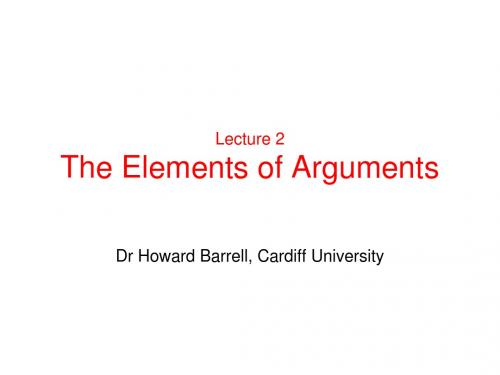
Absent inference indicators
Sometimes an inference indicator may be missing from a bit of reasoning. This can occur when a speaker believes the inference is obvious. This can occur in English and in many other languages For example: It’s raining again; I had better take my umbrella. The actual presence of an inference indicator is not that important. What is important is the relationship of support between the thoughts of the speaker. This relationship is the defining condition of an inference: if two thoughts are linked by such a relationship they constitute an inference; otherwise, they do not.
Identifying elements of an argument 1
Our example of an argument is: The United States accounts for about 30% of world economic output each year. Japan accounts for about 16% of world economic output each year. Therefore, the United States economy is bigger than the Japanese economy. • • • • Which parts of this argument are statements? Which parts are premisses? Where is the inference indicator? Where is the conclusion?
answers
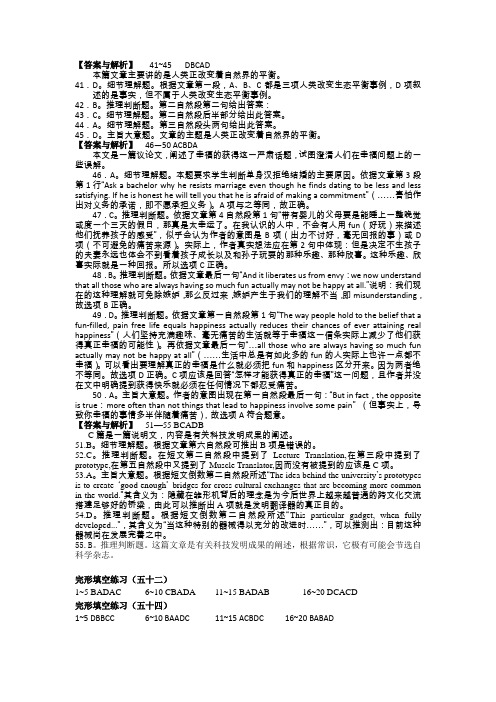
【答案与解析】41~45 DBCAD本篇文章主要讲的是人类正改变着自然界的平衡。
41.D。
细节理解题。
根据文章第一段,A、B、C都是三项人类改变生态平衡事例,D项叙述的是事实,但不属于人类改变生态平衡事例。
42.B。
推理判断题。
第二自然段第二句给出答案:43.C。
细节理解题。
第二自然段后半部分给出此答案。
44.A。
细节理解题。
第三自然段头两句给出此答案。
45.D。
主旨大意题。
文章的主题是人类正改变着自然界的平衡。
【答案与解析】46—50 ACBDA本文是一篇议论文,阐述了幸福的获得这一严肃话题,试图澄清人们在幸福问题上的一些误解。
46.A。
细节理解题。
本题要求学生判断单身汉拒绝结婚的主要原因。
依据文章第3段第1行‚Ask a bachelor why he resists marriage even though he finds dating to be less and less satisfying. If he is honest he will tell you that he is afraid of making a commitment‛(……害怕作出对义务的承诺,即不愿承担义务)。
A项与之等同,故正确。
47.C。
推理判断题。
依据文章第4自然段第1句‚带有婴儿的父母要是能睡上一整晚觉或度一个三天的假日,那真是太幸运了。
在我认识的人中,不会有人用fun(好玩)来描述他们抚养孩子的感受‛,似乎会认为作者的意图是B项(出力不讨好,毫无回报的事)或D项(不可避免的痛苦来源)。
实际上,作者真实想法应在第2句中体现:但是决定不生孩子的夫妻永远也体会不到看着孩子成长以及和孙子玩耍的那种乐趣、那种欣喜。
这种乐趣、欣喜实际就是一种回报。
所以选项C正确。
48.B。
推理判断题。
依据文章最后一句‚And it liberates us from envy:we now understand that all those who are always having so much fun actually may not be happy at all.‛说明:我们现在的这种理解就可免除嫉妒,那么反过来,嫉妒产生于我们的理解不当,即misunderstanding,故选项B正确。
新概念第二册第1课教案

一.课题:Lesson 1 A private conversation 私人谈话2.导入:Today we will talk about one topic---private conversation.(写题目Lesson 1 A private conversation;简单讲解词义---私人谈话) 大家经常去电影院看电影吗?喜欢什么类型的电影?在电影院里遇见过不看电影、大声说话或者看电影看得太入迷、边看边讨论剧情的人吗?(与学员互动)今天,我们要学习的是一个发生在戏院里的事。
主人公兴致勃勃地到戏院看戏,但遇见了一件让他很生气的事,那到底是什么事呢?3.新知识讲解:what do you learn from the passage?Ok, who would like to answer the question? what do you learn from the passage?(与学员互动)好,那我们跟随作者的脚步,来看看他们都具体说了什么?follow me please! 生词与短语讲解:1.private/`praivit/adj. ○1私人的,秘密的a private conversation/letter 私人交谈/信函Eg: they were sharing a private joke.他们讲着外人听不懂的笑话。
private eye 私眼[私家侦探的别称,侦探小说和电影里不可少的角色。
原称private investigator,取后一字首一字母i(读如eye),造成新词private eye.]---拓展学员知识○2私立的,私营的,民营的private companies、enterprise/schools 私营公司、企业/私立学校○3名词形式:privacy n.隐私,私密2.conversation n.(非正式)交谈,谈话○1to get into (a---AmE) conversation with sb.开始与某人攀谈Eg: Don was deep in conversation with the girl on his right.唐与他右边的女孩在深入交谈。
离散数学lecture3

Name Addition Simplification p qµ qµ p Conjunction Modus tollens
q p
´p
´p
qµ qµ qµ
´
´q
rµ q rµ
´p
r µ Hypothetical syllogism Disjunctive syllogism
´p
p p
´p
q
r
Resolution
批注本地保存成功开通会员云端永久保存去开通
Discrete Mathematics Thomas Honold Formal Proofs
Discrete Mathematics
Thomas Honold
Institute of Information and Communication Engineering Zhejiang University
Discrete Mathematics Thomas Honold Formal Proofs
Further Rules of Inference
Making the life a lot easier Rule p µ p q p q µ p p q µ p q q p q µ p p q q r µ p r p q p µ q p q p r µ q r Tautology p p p q p q
Discrete Mathematics Thomas Honold Formal Proofs
Introduction
Fermat’s Last Theorem (FLT)
There do not exist positive integers n x y z with n xn · yn zn 3 and
lecture two
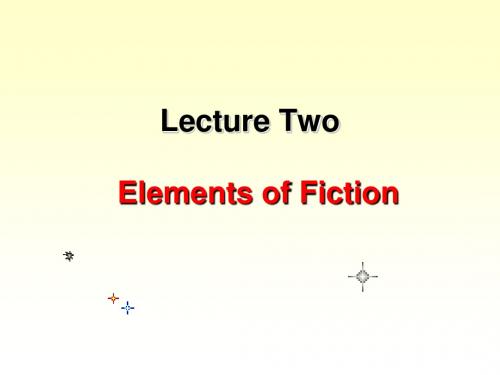
The basic triangle-shaped plot structure was described by Aristotle in 350 BCE. Aristotle used the beginning, middle, and end structure to describe a story that moved along a linear path, following a chain of cause and effect as it works toward the solution of a conflict or crisis.
Theme : The theme of a novel is its controlling
idea or its central insight.
• • • • • • •
Plot and structure Character/ characterization Language theme Point of view Symbol Irony … effect cause
Lecture Two
Elements of Fiction
Contents
• Approaches to literary study • Questions to ask during appreciation • Elements of fiction • Theme, and plot
The Story of an Hour (by Kate Chopin)
Distinguish “story” and “plot” ---- Poetics, Aristotle A sequential order of events is “the story”. A causal arrangement is “the plot”.
Digital Communications, Fundamentals And Applications
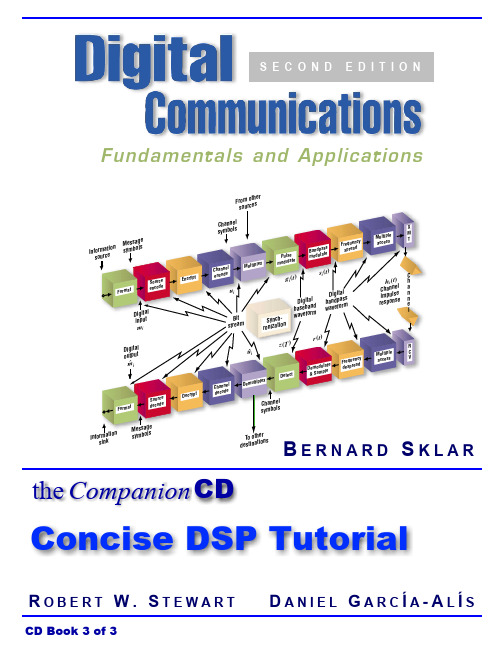
This Document Copyright © BlueBox Multimedia 2001 -
Printing Licence As the owner of the above textbook you are licenced to print one complete copy of this document for your personal use. Additional copies may not be made without the express permission of the copyright owner. Under no circumstances may this document be transmitted to third parties in either electronic or copied paper format.
4.8.1 Phase Compensation 4.8.2 Fractional Delay Implementation
5 6 6 10 12 16 22 28 30 34 36 41 42 45 45 48 50 55 55 59 60 63 63 64 66 70 70 71 73 73 76 79 79 83 87 88 89 89 91 97
Decryp
t
el Chann decode
iplex Demult
Detect
ulate Demod le p & Sam
el Chann ls symbo
atio Inform sink
n
ge Messa ls o b m y s
TheVisualCompute...

TheVisualCompute...The Visual Computer manuscript No.(will be inserted by the editor)1IntroductionGiven two geometric models,one source?A and one target?B,shape metamorphosis generates a sequence2Related WorkAs described previously,most existing3D morphing al-gorithms generally fall into two categories:surface-based approaches and volume-based approaches.Besides these two categories,Turk and O’Brien[26]perform shape transformation between3D shapes by solving a4D in-terpolation problem.Bao et al.[3]present a physically based morphing method via dynamic meshless simula-tion on point-sampled surfaces.Surface-based approaches are usually used for mor-phing3D polygonal meshes,where the correspondence problem and the path[27]problem are believed to be the two main di?culties for mesh morphing methods. The correspondence problem means to?nd a good map-ping(correspondence)between pairs of locations on the boundaries of two meshes.The path problem is to create smooth paths between corresponding vertices of the two meshes,such that no self-intersections happen in the in-termediate meshes.Numerous surface-based approaches have been proposed to deal with these two problems.The readers are referred to[1]for more details.Volume-based approaches do not su?er from these problems[17].They deal deal with sampled or volumet-ric representations of the objects,where the objects are described as(zero)level sets of functions de?ned in the whole3D space.Although it seems that any kind of con-tinuous interpolation between the functions de?ning the source object and the target object will at least pro-3T-spline Level Sets for MetamorphosisIn this section,we give the de?nition of T-spline level sets,and describe how to(approximately)convert the givenobjects(e.g.mesh surfaces)into T-spline level sets. Then we discuss the evolution process of T-spline level sets,in order to transform the shape of the source object ?A into that of the target shape?B.We assume?A and ?B are given by triangular meshes,although other kinds of representations can also be handled by our method.3.1De?nition of T-spline level setsT-splines[24]are generalizations of tensor product B-splines.We now introduce T-spline level sets in3D.Let f(x,y,z)be a trivariate T-spline function de?ned over some domain D,f(x,y,z)= n i=1c i B i(x,y,z)N0N0j=1ω(x j)(f(x j)?d A(x j))2,(4)where x j,j=1,...,N0(N0>>n)is a sequence of sampling points,which are uniformly distributed in the T-spline function domain D.V(D)is the volume of the domain D.In our case,the function f has the form f(x)= b(x)?c,hence the function E is a non-negative de?nite quadratic function of the unknown T-spline control co-e?cients c.The solution c is found by solving a sparse linear system of equations,?E=0,and the initial T-spline level set L0is obtained.If the accuracy of the approximation is not su?cient, a better L0can be found by using more degrees of free-dom(T-spline control coe?cients)and applying the’?-nal re?nement’step[29].The same strategy can be also used for the approximation of the target object after the evolution of T-spline level sets stops.3.3Metamorphosis of T-spline level setsSince the T-mesh is?xed during the morphing process, the T-spline level set function can be written as f(x,τ)=b(x)?c(τ),(5) with the time variableτ.Consider the evolution process ˙x=v(x,τ)n,x∈Γ(f),(6) where the dot of˙x means the time derivative,andv is a scalar-valued speed function along the normal direction n=?f/|?f|ofΓ.In[29],we have shown that this kind of T-spline level sets evolution can be formulated as a least squares problem,where a distance?eld constraint is incorporated to avoid additional branches and singu-larities without having to use re-initialization steps.An extended version of this paper is available as a technical report on the webpage[28].There are a number of choices of the speed function v for the metamorphosis from?A to?B.In order to avoid numerical di? culties and to avoid discontinuities in the solution,v should be continuous.Furthermore,v should carry information about the shape of the target into3D so that shapes tend to”look like”the target as they get nearer.Breen and Whitaker[6]suggest that a natural choice of v is the signed distance transform of the target surface?B or some monotonic function thereof,i.e., v(x)=g(d B(x)),g(0)=0and g′(x)>0,(7) where d B is the signed distance function to the target object?B.The source object will shrink in those areas where it is outside the target object and will expand in those areas inside the target object.It is also proved[6] that if the initial object(L0)and the target object over-lap,the?nal solution of the metamorphosis will be iden-tical to the target.However,direct use of d B as the speed function may cause additional topology changes,which is undesired for a nice morphing process.Figure2shows a morphing example when v(x)=d B(x),where the source object (”?”shape)and the target object(”?”shape)have the same topology(genus0).The morphing sequence in Fig-ure2demonstrates that the”?”shape is?rst split into two components,then one component is vanished and the other component is transformed into the?nal”?”shape.This undesirable artifact is a typical problem for Breen and Whitaker’s method[6]when the source object4Algorithm and ImplementationThis section describes the whole algorithm of3D shape metamorphosis based on the proposed T-spline level set models.The algorithm takes two triangular meshes(the source object?A and the target object?B)and the morphing step size h as input,and produces a sequence of in-between objects(represented by T-spline level sets or triangular meshes)as output.4.1Outline of the AlgorithmThe presented algorithm can be divided into three stages: initialization,evolution,and post-processing.Figure4 shows the?ow chart of our algorithm.In the initialization stage(stage1),the source object ?A is aligned with the target object?B such that the5Experimental Results and DiscussionIn this section,we present some examples to demonstrate and discuss the e?ectiveness of our method.The given source objects and target objects are aligned and nor-malized within a cubic domain D=[?1,1]×[?1,1]×[?1,1].The experiments are run on a PC with AMD Opteron(tm)2.20GHz CPU and3.25G RAM.Please note that all the presented examples are generated fully auto-matically without any user interaction,although interac-tive controls are also possible in the developed software.5.1ExamplesExample1:A bunny morphing into a petal torus.In the ?rst example(see Figure1),the source object(a bunny) is deforming into the target(a petal torus).The T-spline control grid is constructed with2449control coe?cients and shown in(a).The morphing sequence is shown be-tween(b)and(f),where the topology of the objects adaptively changes from genus-0to genus-1.Since the bunny and the petal torus are appropriately overlapped6Conclusions and Future WorkWe have introduced a method for3D shape metamor-phosis based on the evolution of T-spline level sets.The T-spline representation of the level set function is sparse and piecewise rational,the distribution of T-spline con-trol coe?cients can be made adaptive to the geometry of the objects to be morphed.We have also shown that the morphing process of T-spline level sets can be formulated as least squares problems.A fully automatic algorithm is developed to produce metamorphosis between shapes of any topology.For the mesh-based morphing methods,the corre-spondence problem is di?cult[16],especially for two ob-jects with di?erent genus[18].However,this correspon-dence does provide a powerful way for the user to de?ne a desired morphingprocess[14].Since the volume-based morphing methods are parametrization–free,on the one hand they can easily handle complex topology changes, but on the other hand they have problems to(dynami-cally)maintain the correspondence of features betweenReferences1.Alexa,M.:Recent advances in mesh /doc/963407ffc8d376eeaeaa3101.html -puter Graphics forum21(2),173–197(2002)2.Bao,H.,Peng,Q.:Interactive3d /doc/963407ffc8d376eeaeaa3101.html put.Graph.Forum17(3),23–30(1998)3.Bao,Y.,Guo,X.,Qin,H.:Physically based morphingof point-sampled surfaces:Animating geometrical /doc/963407ffc8d376eeaeaa3101.htmlput.Animat.Virtual Worlds16(3-4),509–518 (2005)4.Beier,T.,Neely,S.:Feature-based image metamorphosis.In:Proc.SIGGRAPH’92,pp.35–42(1992)5.Botsch,M.,Bommes,D.,Kobbelt,L.:E?cient linear sys-tem solvers for mesh processing.In:R.M.et al.(ed.) Mathematics of Surfaces XI,LNCS,vol.3604,pp.62–83. Springer,Berlin(2005)6.Breen,D.E.,Whitaker,R.T.:A level-set approach forthe metamorphosis of solid models.IEEE Transactions on Visualization and Computer Graphics7(2),173–192 (2001) 7.Chen,M.,Jones,M.W.,Townsend,P.:Volume distortionand morphing using disk?/doc/963407ffc8d376eeaeaa3101.html puters and Graphics 20(4),567–575(1996)8.Cohen-Or, D.,Solomovic, A.,Levin, D.:Three-dimensional distance?eld metamorphosis.ACM Trans.Graph.17(2),116–141(1998)9.Galin,E.,Akkouche,S.:Blob metamorphosis based onMinkowski /doc/963407ffc8d376eeaeaa3101.html puter Graphics Forum(Proc.Eu-rographics’96)15(3),143–152(1996)10.Hartmann,E.:A marching method for the triangulationof surfaces.The Visual Computer14(3),95–108(1998) 11.He,T.,Wang,S.,Kaufman,A.:Wavelet-based volume morphing.In:Proc.VIS’94,pp.85–92(1994)12.Hughes,J.F.:Scheduled Fourier volume morphing.In:Proc.SIGGRAPH’92,pp.43–46(1992)13.Jin,X.,Liu,S.,Wang,C.L.,Feng,J.,Sun,H.:Blob-basedliquid morphing.Journal of Visualization and Computer Animation16(3-4),391–403(2005)14.Kanai,T.,Suzuki,H.,Kimura,F.:Metamorphosis of ar-bitrary triangular meshes.IEEE Computer Graphics and Applications20(2),62–75(2000)15.Kaul,A.,Rossignac,J.:Solid-interpolating deformations:construction and animation of PIPS.In:Proc.Euro-graphics’91,pp.493–505(1991)16.Kraevoy,V.,She?er, A.:Cross-parameterization andcompatible remeshing of3d models.ACM Trans.Graph.(Proc.SIGGRAPH’04)23(3),861–869(2004)/doc/963407ffc8d376eeaeaa3101.html zarus,F.,Verroust,A.:Three-dimensional metamor-phosis:a survey.The Visual Computer14(8-9),373–389 (1998)18.Lee,T.Y.,Yao,C.Y.,Chu,H.K.,Tai,M.J.,Chen,C.C.:Generating genus-n-to-m mesh morphing using spheri-cal parameterization.Journal of Visualization and Com-puter Animation17(3-4),433–443(2006)19.Lerios,A.,Gar?nkle,C.D.,Levoy,M.:Feature-based vol-ume metamorphosis.In:Proc.SIGGRAPH’95,pp.449–456(1995)20.Nieda,T.,Pasko,A.,Kunii,T.L.:Detection and classi?-cation of topological evolution for linear metamorphosis.The Visual Computer22(5),346–356(2006)21.Pasko,A.,Adzhiev,V.,Sourin,A.,Savchenko,V.:Func-tion representation in geometric modeling:concepts,im-plementation and applications.The Visual Computer 11(8),429–446(1995)22.Payne,B.,Toga,A.:Distance?eld manipulation of sur-face models.IEEE Computer Graphics and Applications 12(1),65–71(1992)23.Rossignac,J.,Kaul,A.:AGRELS and BIBs:metamor-phosis as a B′e zier curve in the space of polyhedra.In: Proc.Eurographics’94,pp.179–184(1994)24.Sederberg,T.W.,Zheng,J.,Bakenov,A.,Nasri,A.:T-splines and T-NURCCs.ACM Transactions on Graphics 22(3),477–484(2003)25.Shoemake,K.:Animating rotation with quaternioncurves.In:Proc.SIGGRAPH’85,pp.245–254(1985) 26.Turk,G.,O’Brien,J.F.:Shape transformation using vari-ational implicit functions.In:Proc.SIGGRAPH’99,pp.335–342(1999)27.Yan,H.B.,Hu,S.M.,Martin,R.:3d morphing usingstrain?eld interpolation.Journal of Computer Science and Technology22(1),147–155(2007)28.Yang,H.,Fuchs,M.,J¨u ttler,B.,Scherzer,O.:Evolutionof T-spline level sets with distance?eld constraints for geometry reconstruction and image segmentation.Tech-nical Report01,http://www.ig.jku.at(2005)29.Yang,H.,Fuchs,M.,J¨u ttler,B.,Scherzer,O.:Evolutionof T-spline level sets with distance?eld constraints for geometry reconstruction and image segmentation.In:Proc.SMI’06,pp.247–252(2006)HUAPING YANG receivedthe BE(1998)degree in hy-draulic engineering and thePhD(2004)degree in computerscience from Tsinghua Univer-sity,China.In2004,he did aone-year postdoc in the com-puter graphics group at theUniversity of Hong Kong.In2005,he starts a postdoc atJKU Linz,Austria,in the?eldof applied geometry,funded bya Marie Curie incoming in-ternational fellowship.His re-search interests include ge-ometric modeling,computergraphics,and scienti?c visual-ization.BERT JUETTLER is pro-fessor of Mathematics at Jo-hannes Kepler University ofLinz,Austria.He did his PhDstudies(1992-94)at DarmstadtUniversity of Technology un-der the supervision of the lateProfessor Josef Hoschek.Hisresearch interests include var-ious branches of applied geom-etry,such as Computer AidedGeometric Design,Kinemat-ics and Robotics.Bert Juet-tler is member of the EditorialBoards of Computer Aided Ge-ometric Design(Elsevier)andthe Int.J.of Shape Modeling (World Scienti?c)and serves on the program committees of various international conference(e.g.,the SIAM conference on Geometric Design and Computing2007).。
NASHAPP
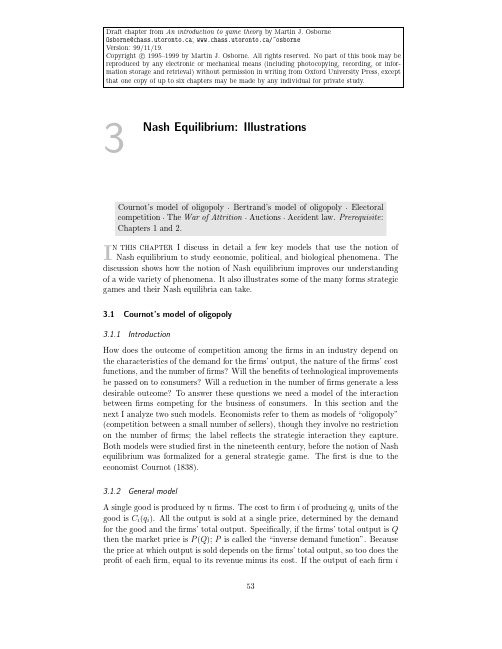
54
Chapter 3. Nash Equilibrium: Illustrations
is qi , then the price is P (q1 + · · · + qn ), so that firm i’s revenue is qi P (q1 + · · · + qn ). Thus its profit is πi (q1 , . . . , qn ) = qi P (q1 + · · · + qn ) − Ci (qi ). (54.1)
To find firm 1’s best response to any given output q2 of firm 2, we need to study firm 1’s profit as a function of its output q1 for given values of q2 . If q2 = 0 then firm 1’s profit is π1 (q1 , 0) = q1 (α − c − q1 ) for q1 ≤ α, a quadratic function that is zero when q1 = 0 and when q1 = α − c. This function is the black curve in Figure 55.1. Given the symmetry of quadratic functions (Section 17.4), the output q1 of firm 1 that maximizes its profit is q1 = 1 2 (α − c). (If you know calculus, you can reach the same conclusion by setting the derivative of firm 1’s profit with respect to q1 equal to zero and solving for q1 .) Thus firm 1’s best response to an output of zero for firm 2 is b1 (0) = 1 2 (α − c). As the output q2 of firm 2 increases, the profit firm 1 can obtain at any given output decreases, because more output of firm 2 means a lower price. The gray curve in Figure 55.1 is an example of π1 (q1 , q2 ) for q2 > 0 and q2 < α − c. Again this function is a quadratic up to the output q1 = α − q2 that leads to a price of zero. Specifically, the quadratic is π1 (q1 , q2 ) = q1 (α − c − q2 − q1 ), which is zero when q1 = 0 and when q1 = α − c − q2 . From the symmetry of quadratic functions (or some calculus) we conclude that the output that maximizes π1 (q1 , q2 ) 1 is q1 = 1 2 (α − c − q2 ). (When q2 = 0, this is equal to 2 (α − c), the best response to an output of zero that we found in the previous paragraph.) ↑ π1 (q1 , q2 ) q2 = 0 q2 > 0
普林斯顿计算机公开课(原书第2版)

第8章络
第10章万维
8.1与调制解调器 8.2有线电视和DSL 8.3局域和以太 8.4无线络 8.5手机 8.6带宽 8.7压缩 8.8错误检测与纠正 8.9小结
9.1互联概述 9.2域名和 9.3路由 9.4 TCP/IP 9.5高层协议 9.7物联 9.8小结
10.1万维是如何工作的 10.2 HTML 10.3 cookie 10.4动态页 10.5页之外的动态内容 10.6病毒、蠕虫和木马 10.7 Web安全 10.8自我防御 10.9小结
普林斯顿计算机公开课(原书第2版)
读书笔记模板
01 思维导图
03 目录分析 05 精彩摘录
目录
02 内容摘要 04 读书笔记 06 作者介绍
思维导图
本书关键字分析思维导图
技术
语言
第版
工作
计算机
课程
硬件
公开课
世界
计算机 小结
编程
普林斯顿
第章
字节
软件
部分
信息
程序
内容摘要
从1999年开始,作者在普林斯顿大学开设了一门名为“我们世界中的计算机”的课程(COS 109: Computers in Our World),这门课向非计算机专业的学生介绍计算机的基本常识,多年来大受学生追捧。本 书就是基于这门课程的讲义编写而成的,书中不仅解释了计算机和通信系统的工作原理,还分析了新技术带来的 隐私和安全问题。第2版的新增章节讨论了Python编程、人工智能、机器学习以及大数据等内容。本书适合所有 希望了解数字世界的读者阅读,通过了解技术的工作原理、起源和未来发展趋势,更好地理解并改变我们身处的 世界。
第5章编程与编程 语言
第4章算法
Patterns to ease the port of micro-kernels in embedded systems
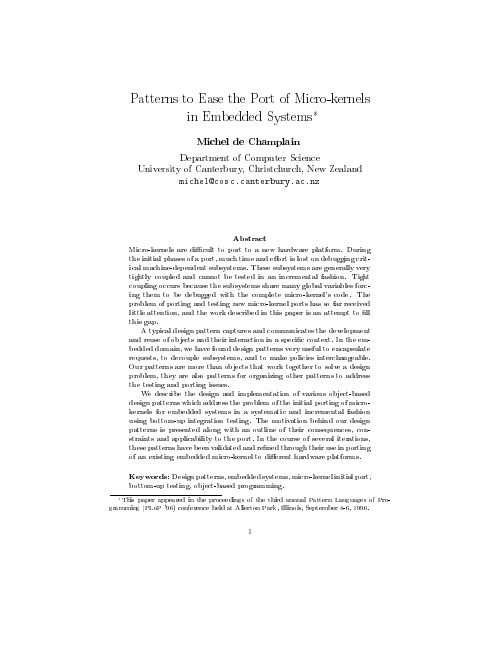
Department of Computer Science University of Canterbury, Christchurch, New Zealand
michel@
Michel de Champlain
Micro-kernels are di cult to port to a new hardware platform. During the initial phases of a port, much time and e ort is lost on debugging critical machine-dependent subsystems. These subsystems are generally very tightly coupled and cannot be tested in an incremental fashion. Tight coupling occurs because the subsystems share many global variables forcing them to be debugged with the complete micro-kernel's code. The problem of porting and testing new micro-kernel ports has so far received little attention, and the work described in this paper is an attempt to ll this gap. A typical design pattern captures and communicates the development and reuse of objects and their interaction in a speci c context. In the embedded domain, we have found design patterns very useful to encapsulate requests, to decouple subsystems, and to make policies interchangeable. Our patterns are more than objects that work together to solve a design problem, they are also patterns for organizing other patterns to address the testing and porting issues. We describe the design and implementation of various object-based design patterns which address the problem of the initial porting of microkernels for embedded systems in a systematic and incremental fashion using bottom-up integration testing. The motivation behind our design patterns is presented along with an outline of their consequences, constraints and applicability to the port. In the course of several iterations, these patterns have been validated and re ned through their use in porting of an existing embedded micro-kernel to di erent hardware platforms.
Springer-Verlag Lecture Notes in Computer Science, 1768)
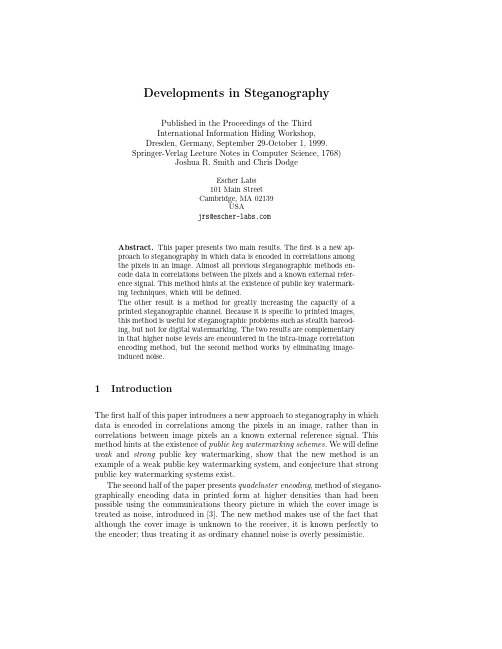
Developments in SteganographyPublished in the Proceedings of the ThirdInternational Information Hiding Workshop,Dresden,Germany,September29-October1,1999.Springer-Verlag Lecture Notes in Computer Science,1768)Joshua R.Smith and Chris DodgeEscher Labs101Main StreetCambridge,MA02139USAjrs@Abstract.This paper presents two main results.Thefirst is a new ap-proach to steganography in which data is encoded in correlations amongthe pixels in an image.Almost all previous steganographic methods en-code data in correlations between the pixels and a known external refer-ence signal.This method hints at the existence of public key watermark-ing techniques,which will be defined.The other result is a method for greatly increasing the capacity of aprinted steganographic channel.Because it is specific to printed images,this method is useful for steganographic problems such as stealth barcod-ing,but not for digital watermarking.The two results are complementaryin that higher noise levels are encountered in the intra-image correlationencoding method,but the second method works by eliminating image-induced noise.1IntroductionThefirst half of this paper introduces a new approach to steganography in which data is encoded in correlations among the pixels in an image,rather than in correlations between image pixels an a known external reference signal.This method hints at the existence of public key watermarking schemes.We will define weak and strong public key watermarking,show that the new method is an example of a weak public key watermarking system,and conjecture that strong public key watermarking systems exist.The second half of the paper presents quadcluster encoding,method of stegano-graphically encoding data in printed form at higher densities than had been possible using the communications theory picture in which the cover image is treated as noise,introduced in[3].The new method makes use of the fact that although the cover image is unknown to the receiver,it is known perfectly to the encoder;thus treating it as ordinary channel noise is overly pessimistic.2Background:Modulation Schemes and Inter-image correlationIn a traditional binary phase shift modulation scheme,each bit b i is represented by some basis functionφi multiplied by either positive or negative one,depending on the value of the bit.The index i is being used to label the bits,and their associated carriers.The modulated message S(x,y)is added pixel-wise to the cover image N(x,y)to create the stego-image D(x,y)=S(x,y)+N(x,y).The modulated signal is given byS(x,y)=ib iφi(x,y)A bit can be recovered by demodulationD,φi = S+N,φi = b iφi+N,φi =b i φi,φi + N,φi ≈b iTo the extent it is possible,the basis functions should be uncorrelated with (orthogonal to)the cover image N.φi,N =1nx,yφi(x,y)N(x,y)≈0where n is the total number of pixels summed over.As pointed out in[2],the cover image N typically has a large non-zero DC component,since by convention luminosity values are taken to be positive,and thus the carrierφshould have zero DC component.If the carrier has a non-zero DC component,there will be a large noise contribution from the inner product of the cover image’s DC component with the carrier’s DC component.2.1Direct-Sequence Spread SpectrumIn the implementation of direct sequence spread spectrum in[3],the modulation function consists of a constant,integral-valued gain factor G multiplied by a pseudo-random blockφi of+1and−1values.Each blockφi has a distinct loca-tion in the(x,y)plane.The use of blocks is not a necessity.In some applications, it might be desirable to interleave the carriers so that each one is spread over the entire area of the image.The embedded data is recovered by demodulating with the original modulat-ing function.A TRUE(+1)bit appears as a positive correlation value;a FALSE (−1)bit is indicated by a negative correlation value.Once the carrier phase has been recovered,we project the stego-image onto each basis vectorφi:o i= D,φi =1nx,yD(x,y)φi(x,y)and then threshold the o i values to recover the bits b i.In this scheme,as in many steganographic schemes,information is encoded in correlations between the pixel values and an external reference vectorφthat must be made available to any decoder.3Intra-image correlation3.1Motivation:Public Key WatermarkingWe will define the term public key watermarking to mean a watermarking scheme with the property that the knowledge required to read(or verify)the hidden wa-termark data provides no additional help in stripping the watermark.This term should not be confused with public key steganography,which Anderson defined to mean the problem of communicating information through a steganographic channel using an asymmetric cryptosystem to keep the contents of the hidden data secret.A public key watermark is not supposed to be secret—it should be readable by anyone in possession of the public key—but only someone with the secret key should be able to remove it and recover a clean,unmarked original.This is not to say that a public key watermark cannot be jammed:a large amount of noise can always be added blindly,for example.Nor is it to say that access to an oracle that can read watermark bits would not help:then modifications to the image can be tested until the watermark is unreadable. Definition1A strong public key watermarking scheme has the property that performing the decoding algorithm oneself,using the public key,confers no ad-vantage(or vanishingly small advantage)in stripping the watermark above that provided by access to a watermark-reading oracle or server.With knowledge of the private key,the watermark can be stripped and the original source image recovered.Definition2A weak public key watermarking scheme has the property that performing the decoding algorithm oneself,using the public key,does not confer the ability to exactly strip the watermark and recover a clean copy of the original. With knowledge of the private key,the watermark can be stripped and the original source image recovered.In either the strong or the weak form,the decoder must in some(strong or weak)sense not be able to determine“where”the data is hidden.A spread spectrum demodulation algorithm that was capable of extracting modulated bits given received data and an encrypted version of the carrier,without ever decrypting the carrier,would probably qualify as a strong public key watermark-ing system.We conjecture that strong public key watermarking schemes exist,though producing them will require a novel combination of cryptography and signal processing.Thefirst part of this paper presents a weak public key watermarking scheme.3.2Intra-image methodsThe technique introduced in this section encodes information in correlations among the pixels within an image,rather than in correlations between an image and an external reference.A consequence of this approach is that the ability toread the message does not confer the ability to exactly strip out the message.Thus,the method is a weak public key watermarking system.The only previous investigation of intra-image correlation we are aware of is the“texture-block coding”scheme described in[1].In this scheme,a texturedregion is identified by a human operator,copied,and then pasted into anotherarea of the image,replacing whatever pixels were originally at the destination location.The shape of the region can be tailored to represent information,forexample,the characters“MIT.”The main drawback of this scheme is the re-quirement to manually identify regions of corresponding texture.For the schemeto be imperceptible,the source and destination regions have to be similar-lookingregions of high texture.This means that the information is not stored in a pre-defined set of pixels.Thus an additional drawback is that decoding requirescalculating the full2d autocorrelation function of the image,in order to discoverwhere the information is encoded.The information cannot be placed in afixed location because its location depends on the human user’s choice.The method presented in this section is automatic on encode and decode, and does not require a full autocorrelation calculation to perform the extraction.The method is as follows.Break the pixels of the cover image into two disjointsubsets of equal size.Then we can treat the pixels in thefirst subset as a vector D1,and the pixels from the second subset as vector rmation can be encoded in correlations between these two portions of the image,rather thanbetween the image and an external carrier.A TRUE bit will be represented by positive correlations between the sub-regions,and FALSE will be represented by negative correlations(anti-correlation).Consider two sub-regions of an image that are being used to encode a single bit b(either+1or-1).We can write thefirst sub-region as D1=N1+χand the second as D2=N2+bχ,where N1and N2are portions of the original unmodified“noise”image,b is the bit being encoded(+1or-1)andχis a random sequence that is generated in the course of encoding,but then may be thrown away.Like classical correlation-based steganography methods,the decoder does not need to know the original image N.The novel feature of this scheme is that the decoder does not need to knowχ,either.The decoder does needs to know,for each D1pixel,which D2 pixel is associated with it.The naive decoding algorithm would take the inner product of D1,D2 . Because of the large DC components of N1and N2,however,the signal would be swamped.To see this,we can write an expansion of N1into its DC component plus all other terms,N1=N01+N 1,where N01is the DC component.The naiveinner product isD1,D2 =N01+N 1+χ,N02+N 2+bχSince images are by convention positive,both images will have large DC com-ponents N01and N02,which will make a large contribution to this inner product. Subtracting offthe DC components before taking the inner product eliminates the large contribution that would otherwise arise.Thus a much better demodu-lation method isD1− D1 ,D2− D2where D1 denotes the mean of D1,taken bit-blockwise.3.3Geometric interpretationClassical schemes add a vectorial component to the image and represent infor-mation in the angle(typically0or180degrees)between this component and a known external reference vector.1The method presented here represents infor-mation in the relative angle between two vectors that are parts of the image;the absolute angle of these vectors may be completely unknown to the receiver.Because data extraction in traditional methods is accomplished by measuring the angle to a reference vector that must be specified to the receiver,the knowl-edge required to optimally read data necessarily confers the ability to exactly strip out that data.In order to extract data using the method presented here, the receiver need know nothing about the absolute angle(in Hamming space) at which the data is stored.3.4A weak public-key watermarking schemeSuccessfully decoding a bit reveals,for the blocks or sets of correlated pixels, whether the correlation is positive or negative.But for any pair of pixels,it does not reveal whether the positive correlation was due to a(+1,+1)change, or a(−1,−1)change.Similarly,negative correlation could be caused by either (+1,−1)or(−1,+1).(An additional source of confusion arises from the image noise.)This information(whether the contribution made by a pair of pixels to the overall positive correlation is due to a(+1,+1)change or a(−1,−1)change), which constitutes the absolute angle at which the data is encoded,is known only by the encoder,not the decoder.A decoder who came into possession of this information could exactly strip out the watermark,and recover the original image.The absolute angle at which the data is encoded can be viewed as a private key that can be used to strip out the hidden data(that isχis a private key). The public key needed to read the data is the sequence of paired pixels.3.5AttacksAlthough the receiver does not need knowledge ofχto read the data,this is unfortunately not equivalent to the statement that the receiver cannot acquire some knowledge of where the information is stored.Knowledge that a pair of pixels is probably positively correlated,plus knowledge of whether each pixel is greater or less than the mean value of its block,yields some information about χ.An estimate ofχ,even if it is not exactly correct,can be used to reduce the power of the watermark.1This is because the inner product a,b =|a||b|cos(θ).If a and b are normalized so that|a|=|b|=1,then the inner product returns the cosine of the angle between a and b.There are two attacks on the intra-image encoding method that will reliably eliminate the watermark,though at the cost of further damage to the image. Thefirst attack is to bring the correlation of each of the blocks toward zero.If a pair of blocks is positively correlated,than add negative correlation until the correlation score is close to zero.Flip a coin to determine whether to stop on the positive side of zero,or the negative side.(Replacing all positive correlations by negative correlations would have the effect of inverting,but not removing,the watermark).The second attack is simply to blindly encode some other message.This attack highlights the fact that this scheme is not as asymmetric as one would like. Though the ability to read does not confer the ability to recover the unmarked image,it does confer the ability to overwrite the original watermark.3.6Capacity of Intra-Image correlation schemeFor purposes of analysis,this scheme can be mapped onto a classical inter-image correlation method.The channel capacity formula isC=W log2(1+S N)The demodulation method is bχ+N1− N1 ,χ+N2− N2 =b+ N1,χ + b χ,N2 + N1− N1 ,N2− N2 ,as compared with bφ+N1,φ =b+ φ,N1 for classical schemes.Assuming that N1and N2are uncorrelated withφand χ,then N1,χ = χ,N2 = φ,N1 .Thus the noise power for the tradi-tional algorithm is φ,N1 ,and the noise power for the intra-image method is2 φ,N1 + N1− N1 ,N2− N2 .Clearly the noise power is significantly higher for the intra-image method.3.7ImplementationWe have used the intra-image correlation method to encode the Gatlin image used in[3]with100bits of information.2A gain of14percent of the total dynamic range(changes of±9,with the original image ranging from0to64)was required to recover all100bits accurately.As expected,the performance is worse than [3],which hid100bits in the same image using lower gains.The level of gain required is clearly unacceptable from a perceptibility standpoint.However,the quadcluster noise reduction scheme in the second half of the paper could be combined with the intra-image encoding scheme to improve performance.4Quadcluster encodingA shortcoming of the intra-image encoding method is that it effectively has less signal-to-noise to work with,because(to translate into traditional terminology) 2Specifically,we are using thefirst320x320pixels of the Gatlin image,which is available in Matlab via the“load gatlin”command.Fig.1.320by320image encoded with100bits using intra-image correlation encoding. As expected,this method requires higher gain to achieve the same level of capacity achieved by the direct sequence scheme in[3].the demodulating carrier has been corrupted with noise.The quadcluster encod-ing method allows the effect of cover image noise to be eliminated completely in a printed context.This noise reduction would render the intra-image encoding technique practical(in a printed context).The cover image is often taken to be noise that limits the performance of the steganographic communication channel,as in the scheme and analysis presented in[3].Although the cover image is not known in advance by the receiver,the cover image is not strictly speaking noise.For example,the“noise”due to the cover image will be the same each time the image is scanned,unlike the true noise that arises from the circuitry in the scanner,which will be different each time the image is scanned.Furthermore,the cover image is known in advance to the encoder,unlike true channel noise.Because the cover image noise is not truly noise,it turns out not to limit the communications rate.We will make use of this insight,as well as the fact that the cover image does not occupy all the spatial bandwidth that is accessible to modern printers and scanners.The quadcluster method can be explained as follows.Up-sample the cover image by a factor of2in each dimension,so that each original pixel is mapped to a cluster of4identical pixels.The up-sampled image now contains4times more pixels than the original,since each original pixel has been copied4times. We will use the term sub-pixels to refer to the4identical pixels that were copied from a particular original pixel.Now if we encode data using any modulation-based information hiding scheme,such as the ones described in[3],but leave one sub-pixel in each quadcluster unchanged,we can achieve complete immunity to the effects of“noise”due to the cover image.Without loss of generality, suppose that the unmodified pixel is the top left member of the cluster.To demodulate,we subtract the value of the unmodified top left pixel from the other pixel values in the same cluster,and then perform the usual demodulationoperation of projecting onto the basis function that was used to encode the information.We will describe better implementations of this basic idea later.Current consumer ink jet printers have resolution specifications of1440dots per inch and higher,and photos meant for display on personal computer screens typically need only72to100dots per inch resolution to display them at rea-sonable size,so the up-sampled and encoded image can typically be printed at twice the original resolution(that is,exactly the same size as the original)by taking advantage of this unused resolution.In practice,leaving one sub-pixel unmodified is not be the best implemen-tation.In our implementation described below,we generated one carrier“chip”value(+G or-G)for each pixel,not for each sub-pixel.The change made to each sub-pixel is determined by the product of the sub-carrier,the carrier,and the bit value.The sub-carrier values are chosen to sum to zero.This way,the original pixel value can be recovered by averaging the four associated sub-pixels. In our implementation,afixed sub-carrier pattern of+1,-1,+1,-1was used(with the labeling starting in the top left corner of the quadcluster and moving around clockwise).A variety of other sub-carrier sequences could be chosen,as long as the constraint that the sub-carrier values in a cluster sum to zero is obeyed.Each pixel can be upsampled by factors other than2in each dimension,for example 3x3for nine sub-pixels,or4x4for16sub-pixels.In the context of printers with different horizontal and vertical resolution specifications,8x4might be a sensible upsampling.In general,the requirement is that it must be possible to estimate the original source pixel value from the sub-pixels.4.1RegistrationIt is a commonplace of the information hiding literature that spread spectrum techniques suffer from a need for precise registration between the encoded image and the demodulating carrier.The quad-cluster method is even more sensitive to misregistration than ordinary spread spectrum methods,and shows that or-dinary spread spectrum methods actually do have some robustness to misregis-tration,when compared with the worst case.Suppose that an image encoded with the spread spectrum method described in[3]has been placed on the scanner with a slight skew.Consider a32x32pixel block at the top left corner of the image,and suppose this block represents a single bit.Suppose further that because of the skew,the carrier being used to demodulate is registered correctly for the top left16x16quarter of this block,and misregistered in the rest of the block.A signal strength could be chosen such that this bit would be correctly demodulated,despite the fact that three quarters of the pixels are misregistered.Because this algorithm makes no assumptions about the cover image,treating it as noise,misregistration causes the signal power from the misregistered region to drop to zero,but has on average no effect on the noise power from this region.Since the contents of the cover image are treated as noise,there is a significant noise contribution from the cover image regardless of whether it is properly registered.Misregistered noise is no more harmful than “properly registered”noise.In the quad-cluster method,misregistration causes a significant increase in cover image noise,as well as a decrease in signal.When the carrier is properly registered,there is zero contribution from cover image noise.When the carrier is “fully misregistered”(meaning every pixel in a carrier block misregistered),the cover image contributes potentially just as much noise as in the ordinary spread spectrum technique.Thus the quad-cluster method is much more sensitive to registration,as measured by the fall offof SNR as a function of the number of misregistered pixels.4.2ImplementationThe obvious question given the discussion in the previous section is whether it is possible in practice to register the image and the carrier precisely enough to get the benefits of the quad-cluster method.Perhaps the increased noise due to misregistration offsets the noise savings offered by the method.The answer to the question of whether precise enough registration is possible is a resounding yes.In the320x320pixel Gatlin image,shown infigure2,in which100bits were hidden in[3]“on screen”(not printed and scanned)and with perfect registration,we can now hide1024bits and extract them with100 percent accuracy after printing and scanning.First the dynamic range of the original6bit gray scale image was expanded tofit into a standard8bit range of brightness values.The original was upsampled from320x320pixels to640x640pixels using nearest-neighbor interpolation -i.e.each source pixel was duplicated into a2x2block.This image’s dynamic range was then slightly compressed and its bias was slightly raised in order to avoid non-linear clipping distortion caused by pixel saturation.1024data bits were encoded with the quad-cluster modulation method at a gain setting of7.8 percent(changes of+-20out of255)using a carrier block size of10x10.The test image was printed on an HP895C ink jet printer and on an Epson Color Stylus740ink jet at maximum nominal resolution(600dpi and1440dpi, respectively)on plain copier paper.Thefinal printed size of the image was4.4”x 4.4”.The scanning was performed on a Hewlett Packard ScanJet4c with a scaling setting of500percent,yielding a color-scanned image of approximately1675 pixels x1675pixels.The scanned image was low-passfiltered with a2D Gaussian kernel and subsequently downsampled,using nearest-neighbor interpolation,to a640x640image.This post-processed scanned image was block-aligned and decoded by an algorithm implemented in C.Although the original test image was monochrome, we used a color scanning process to“oversample”the image,thereby smoothing out some of the noise introduced by the scanning circuitry.The red,green,and blue color planes were separately aligned in order to account for non-colinearity of the red,green,and blue detectors in the scanner.Using this procedure,a decoding accuracy of100percent was achieved:all 1024bits were decoded correctly.Presumably,even better overall performance could be achieved by going to higher data densities and employing an error correcting code.From the perspective of decreasing perceptibility,a gain of9(rather than20)resulted in98percent bit decoding accuracy,and rendered the hidden data effectively invisible.The gain of20was chosen partly to exagerate the changes so that they would become visible.Fig.2.Unmarked Gatlin image.Fig.3.Gatlin image with1024bits encoded using quadcluster encoding at a gain level of7.8percent(±20/255),10x10block size.The linear resolution of this image is greater than the original by a factor of2.5ConclusionThe intra-image encoding method isfirst example of a weak public key water-marking scheme.The ability to read the message does not confer the ability to produce a“clean”copy.As a steganographic method,it suffers from poor per-formance,due to its high susceptibility to image noise.The quad-cluster method utilizes the advance knowledge of cover image“noise”available to the encoder, plus the high spatial frequencies accessible to modern printers and scanners,to effectively cancel the effects of image noise.The quad-cluster method is certainly very useful by itself for imperceptibly encoding large amounts of data in images. It also should render the intra-image encoding technique usable as a stegano-graphic technique(i.e.a method for transmitting large amounts of data,not as a watermarking technique),by reducing the image noise levels encountered by the intra-image encoding scheme.The application of the intra-image encoding technique for weak public key watermarking in a printed context(in which one might imagine gaining the benefit of the quad-cluster method)is less compelling, since once the image is printed,there is no longer any possibility of recovering a clean original,regardless of what encoding scheme is used.3In introducing the quad-cluster modulation scheme,we have pointed out that the level of channel noise is substantially different for the transmitter and the receiver.For the transmitter,the cover image is not strictly speaking noise,be-cause the transmitter has exact knowledge of the cover image;for the receiver, it is more accurate to call the cover image noise.Quad-cluster encoding makes use of the higher spatial frequencies accessible to modern printers,but it also makes use of the steganographic channel’s“asymmetric noise levels.”One inter-esting open question is how the asymmetric noise levels alter the usual channel capacity calculation.Another open problem that arises from the second half of this paper isfinding other modulation schemes that make use of the noise level asymmetry of steganographic channels.Finally,finding examples of strong pub-lic key watermarking schemes,or proving the non-existence of such schemes,is the most significant open problem posed by this paper.References1.W.Bender,D.Gruhl,and N.Morimoto.Techniques for data hiding.IBM SystemsJournal,35(3and4),1996.2.J.P.Linnartz,T.Kalker,and G.Depovere.Modelling the false alarm and misseddetection rate for electronic watermarks.In Proceedings of the Second International Information Hiding Workshop,Portland,Oregon,1998.3It is natural to wonder whether embedding data with a standard,symmetric water-marking scheme and then printing the encoded picture qualifies trivially as a weak public key watermarking scheme.It does not,because although the ability to read the message does not confer the ability to exactly strip the message,there is no private key that would enable recovery of the original,unwatermarked image.3.J.R.Smith and iskey.Modulation and information hiding in images.InProceedings of the First International Information Hiding Workshop,Isaac Newton Institute,Cambridge,U.K.,1996.This article was processed using the L A T E X macro package with LLNCS style。
Unit-8-Two-Boxes-of-Gold市公开课一等奖省赛课微课金奖PPT课件
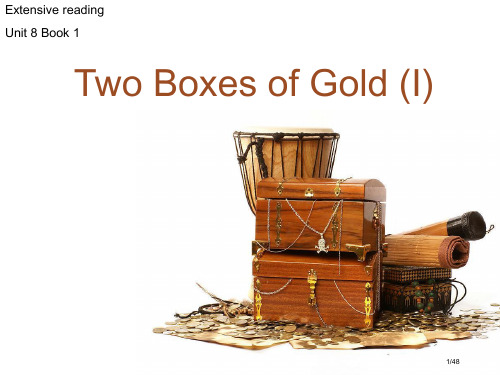
Part 2 Receiving the urgent task
1. What was Herbert asked to do when he met Mr. Schwarzmoor?
He was asked to take some gold to Naples.
18/48
Part 2 Receiving the urgent task
Did the man answer the question from Mr. Levison about the content of the boxes? 6. Did they see each other when they reached Paris? Why did Levison look very angry when the Major met him and the man in a restaurant at Dromont? 7. What happened when they were 32 kilometers away from Lyons on the train?
6/48
Conan Doyle (1859—930)Sir Arthur Ignatius Conan
Doyle was a British writer and
physician, most noted for
creating the fictional detective
Sherlock Holmes and writing
15/48
Part 1 Leaving for Italy
2. What was the telegram about? • Start for Italy at once on important business • Start from London Bridge • Catch Dover night boat
【双语加工研究】Lecture 10
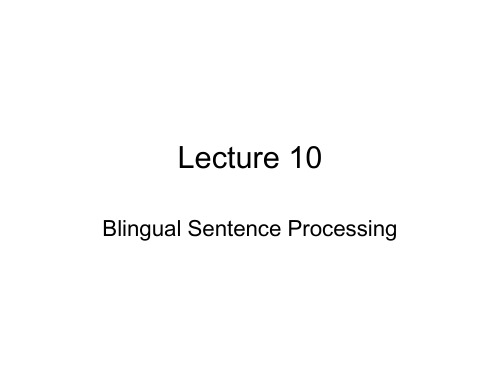
• 该原则主要内容如下: 1)只要有可能,就应将新输入的语言单位看作一种 主要成分。否则,就将其作为非主要成分归入到 当前论旨范围(current thematic domain)进行 处理。所谓当前论旨范围指的是支配题元角色的 最近成分。
2)运用结构性(structural)和非结构性(nonstructural)的原则处理当前论旨范围中的非主要 成分。非结构性的原则包括指称原则(语篇中已 经存在所指)、Grice的合作原则(避免歧义)以 及语言规则等(参看牛萌萌、吴一安,2007)。
• 作为互动论的代表人物之一,Tanenhaus et al (1989)认为,结构是由组合词汇信息 (combinatory lexical information)决定的。 与此相对,模块论的代表人物Frazier et al (1996) 认为句法结构是由句法信息决定的, 不受语义的影响。
• 句法分析是理解句子中物体和事件关系的 重要步骤。句法分析的过程就是我们决定 将新输入的词语放在我们正在建立的短语 结构什么地方的过程。这里存在一个问题, 即我们是什么时候作出这样的决定的?是 遇到一个词就决定它在句子树形结构中的 位置还是等到一定的时候再作决定?Just & Carpenter (1980)认为,我们遇到一个新 输入的词就会从长时记忆中提取其意思, 辨认其指称,然后把它放在句法结构里。 他们称之为即时原则(immediacy principle)。
• “最少依附原则”是一个典型的模块论模 型,它认为句子理解是一个两步过程(twostage processing):
• 在句子加工过程中句法分析是第一位的, 语义、语用等信息只是在句法分析之后才 发生作用(Hoeks et al., 2006; Kennison, 2001)。
- 1、下载文档前请自行甄别文档内容的完整性,平台不提供额外的编辑、内容补充、找答案等附加服务。
- 2、"仅部分预览"的文档,不可在线预览部分如存在完整性等问题,可反馈申请退款(可完整预览的文档不适用该条件!)。
- 3、如文档侵犯您的权益,请联系客服反馈,我们会尽快为您处理(人工客服工作时间:9:00-18:30)。
Focal color/typical color
• Arbitrary or universal?
• 3 dimensions: a) hue b) brightness c) saturation
bright
•dark red red-purple Munsell Color Chips
Findings _ by Rosch
e.g. 1. Our car has broken down. 2. Dad exploded. 3. I’m the heavy burden of my parents. e.g. 3-1: The car crashed into the tree. 3-2. The tree was hit by the car. 4-1: the book on the desk 4-2: the desk under the book e.g. 5-1: “The car crashed into the tree.” in a road accident. 5-2: The car started to swerve. 5-3: the car skidded across the road and rumbled onto the edge.
family resemblance
Item 1 2 3 4 Attributes AB BC CD ED Overlapping similarities A B B C C D D E
GESTALT
Gestalt
• The motto of Gestalt theory: The whole is greater than the sum of its parts.
prototype
• Prototypical
shapes organisms objects
• Prototypical
• Prototypical
Graded centrality: how close a member
is to the best example (prototype)
• Goodness-Of-Exemplar (GOE) • GOE scores correlating to a number of independent properties
Paul Kay Brent Berlin
Prototypes
William Labov Eleanor Rosch
Lawrence Xing
Experiential view
3 Cognitive views Contents of Chapter 1
Prominence view Attentional view
arrangement of information in a clause based on the importance
Attentional view: explanation of the selection and
arrangement of information in a clause based on its attraction to people’s attention
Theses/dissertations on category
• • • • • • • • • • • • • • • • • • 基于范畴的意义观认知语言学视野下的话语理解 范畴化理论在汉语古诗英译中的应用 汉英比较范畴的认知对比研究 范畴化及原型理论对英语委婉语的分析 情态范畴的认知研究 次范畴化与英语名词短语中修饰语的研究 英语被动语态的原型范畴研究 原型范畴理论指导下的高中英语词汇教学 英语名词的非范畴化 英汉空范畴对比研究 英语动词—ing结构的非范畴化研究 范畴因素对汉字双字词知觉干扰效应的影响 类典型及基本层次范畴理论在词语翻译中的运用 语义层面上标记性的原型范畴研究 名词非范畴化的制约因素 多义性在原型范畴理论上的认知研究 汉英使役范畴表达形式的对比研究 认知范畴的边界特征研究
• • • • •
Frequency and order of mention Order of learning Family resemblance Verification speed Priming
Attributes/properties/features
• Good example (bird) Bad example (bird)
• Focal colors are more salient than non-focal colors. • Focal colors are more accurately remembered in short-term memory and more easily retained in long-term memory. • The names of focal colors are more rapidly produced in color-naming tasks.
External structure
Contextቤተ መጻሕፍቲ ባይዱ
Cultural modals
Three
cognitive views
Experiential view: perception of the world Prominence view: explanation of the selection and
Context External structure Cultural modals
• VEGETABLE • • • • • • • LEEK, CARROT BROCCOLI, PARSNIP CELERY, BEETROOT AUBERGINE, COURGETTE PARSLEY, BASIL RHUBARB LEMON
GOE rating 1 2 3 4 5 6 7
GOE scores correlating to a number of independent properties
Principles of gestalt
• • • • •
proximity similarity closure continuation prominence
Archetype
and
Prototype
Archetype--- instinct, unlearned Prototype---best example of a category
Internal Structure Categories External structure
Focal colors Prototypical shapes/ organisms/ objects Internal Structure Prototype Attributes Family resemblances Boundary Gestalt
